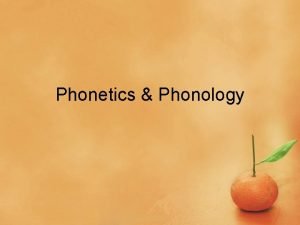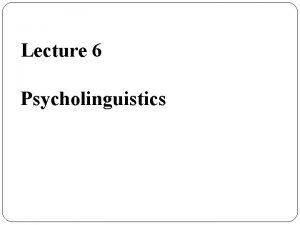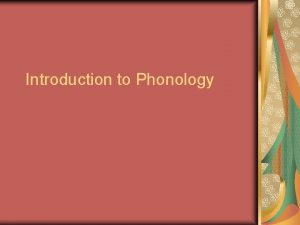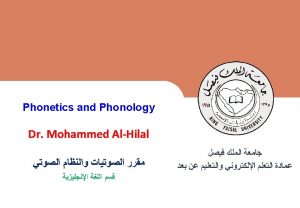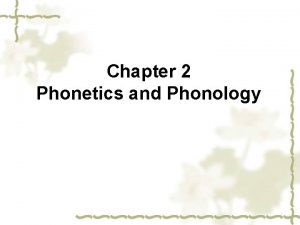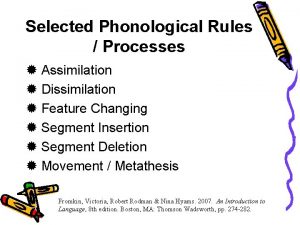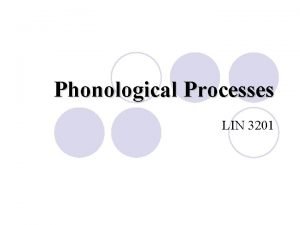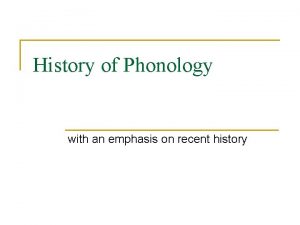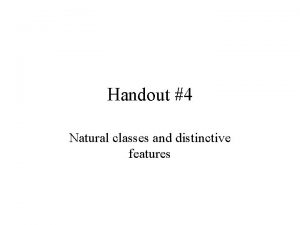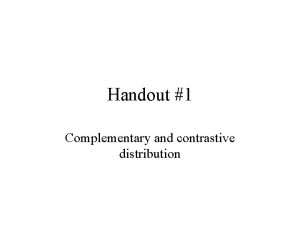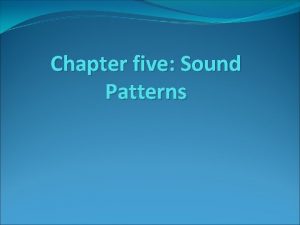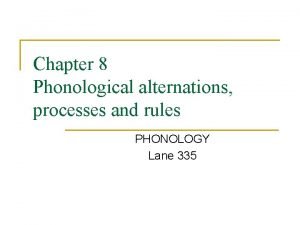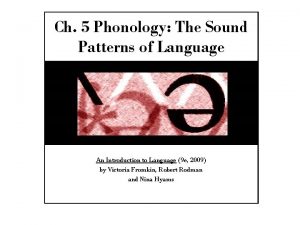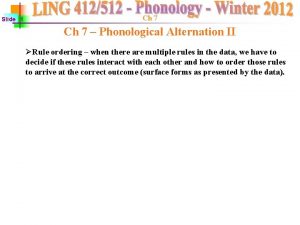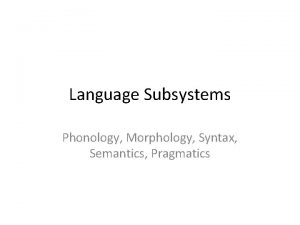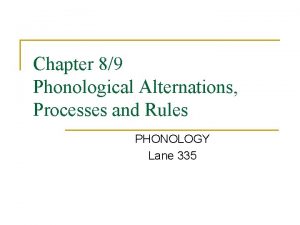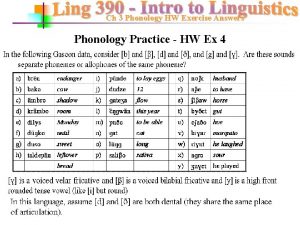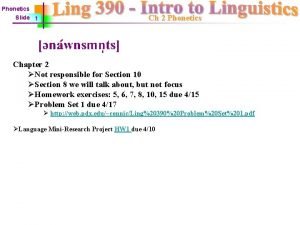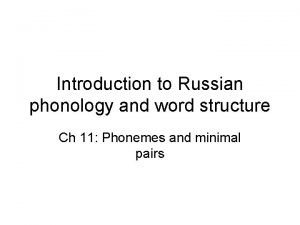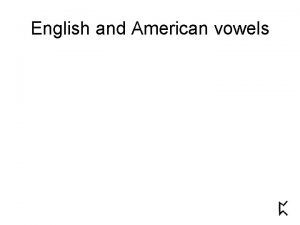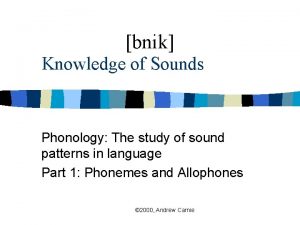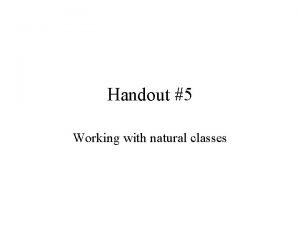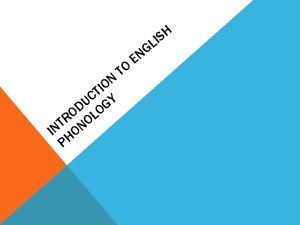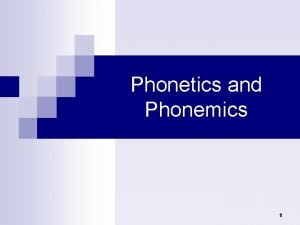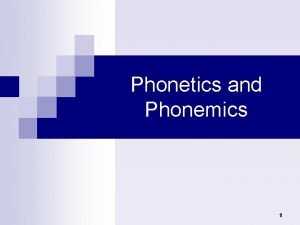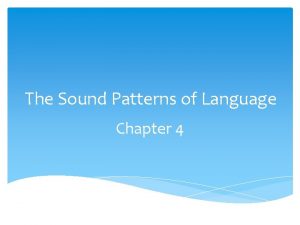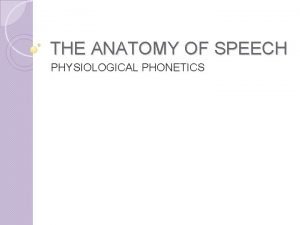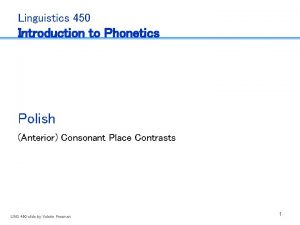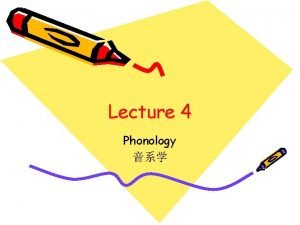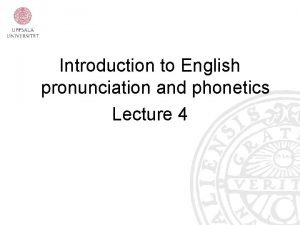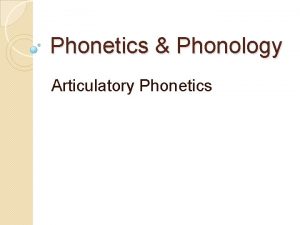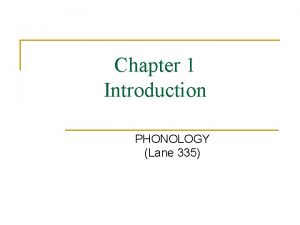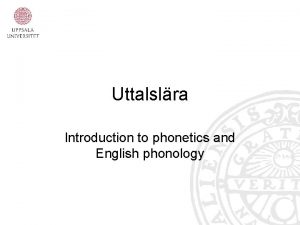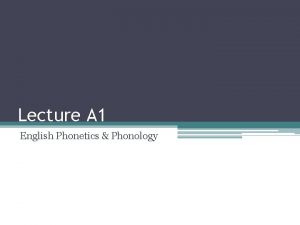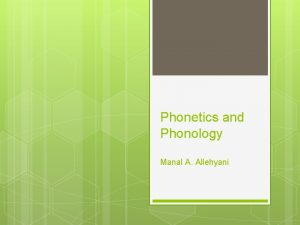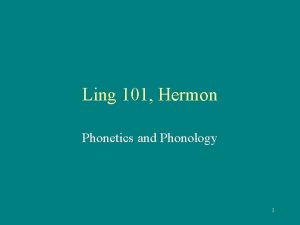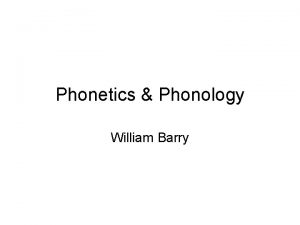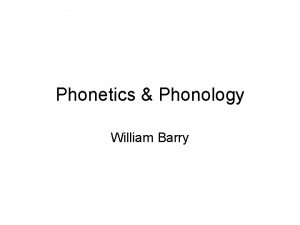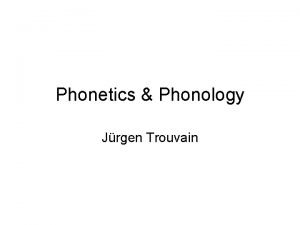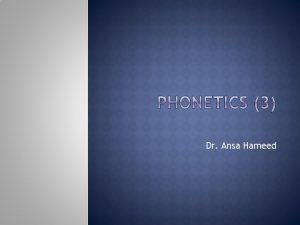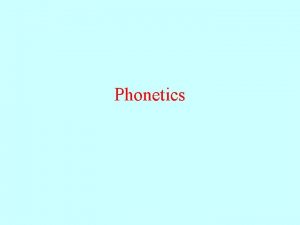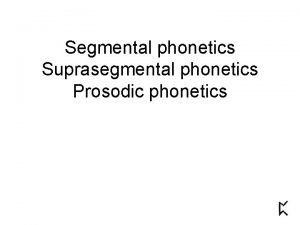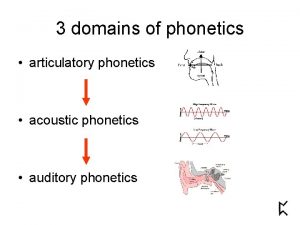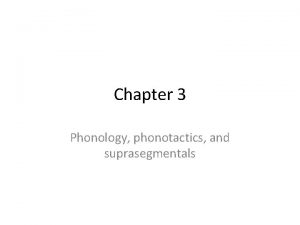Chapter 2 Phonetics and Phonology Phonetics Phonetics is














![The manner of articulation • stops/plosives: [p], [b], [t], [d], [k], [g]; 爆破音 • The manner of articulation • stops/plosives: [p], [b], [t], [d], [k], [g]; 爆破音 •](https://slidetodoc.com/presentation_image_h2/77f661de72272b09c6e196107e965d1a/image-15.jpg)
![The place of articulation • • bilabial: [p], [b], [m], [w]; labiodental: [ f The place of articulation • • bilabial: [p], [b], [m], [w]; labiodental: [ f](https://slidetodoc.com/presentation_image_h2/77f661de72272b09c6e196107e965d1a/image-16.jpg)

![The description of English consonants Place manner Voicing Bilabial Stops or plosives VL [p] The description of English consonants Place manner Voicing Bilabial Stops or plosives VL [p]](https://slidetodoc.com/presentation_image_h2/77f661de72272b09c6e196107e965d1a/image-18.jpg)


![According to the openness of the mouth • Close: [I: ], [I], [u: ], According to the openness of the mouth • Close: [I: ], [I], [u: ],](https://slidetodoc.com/presentation_image_h2/77f661de72272b09c6e196107e965d1a/image-21.jpg)


![According to the length of the vowels • long: [I: ], [E: ], [u: According to the length of the vowels • long: [I: ], [E: ], [u:](https://slidetodoc.com/presentation_image_h2/77f661de72272b09c6e196107e965d1a/image-24.jpg)
![Diphthongs/gliding vowels • [ei], [a. U], [EU], [Ri], [i. E], [ZE], [UE]. Diphthongs/gliding vowels • [ei], [a. U], [EU], [Ri], [i. E], [ZE], [UE].](https://slidetodoc.com/presentation_image_h2/77f661de72272b09c6e196107e965d1a/image-25.jpg)


























- Slides: 51

Chapter 2 Phonetics and Phonology

Phonetics ----Phonetics is defined as the study of the phonic medium of language; it is concerned with all the sounds that occur in the world’s languages. ----It is a branch of linguistics which studies the characteristics of speech sounds and provides methods for their description, classification and transcription, e. g. [p] bilabial, stop.

Three branches of phonetics • Articulatory phonetics (发音语音学)----from the speakers’ point of view, “how speakers produce speech sounds” • Auditory phonetics (听觉语音学)----from the hearers’ point of view, “how sounds are perceived” • Acoustic phonetics (声学语音学)----from the physical way or means by which sounds are transmitted from one to another.


Question: Phonetic similarity & Phonetic identity

Speech organs: three important areas • Pharyngeal cavity ---- the throat; • The oral cavity ---- the mouth; • Nasal cavity ---- the nose; • Larynx • Tongue


The diagram of speech organs 1. Lips 2. Teeth 3. Teeth ridge (alveolar) 4. Hard palate 5. Soft palate (velum) 6. Uvula 7. Tip of tongue 8. Blade of tongue 9. Back of tongue 10. Vocal cords 11. Pharyngeal


Orthographic representation of speech sounds ---- A standardized and internationally accepted system of phonetic transcription is the International Phonetic Alphabet (IPA). The basic principle of the IPA is using one letter to represent one speech sound. • Broad transcription ---- used in dictionary and textbook for general purpose, without diacritics, e. g. clear [ l ], [ pit ] • Narrow transcription ---- used by phonetician for careful study, with diacritics, e. g. dark [ l ], aspirated [ p ]

Some major articulatory variables ---- dimensions on which speech sounds may vary: • Voicing---- voiced & voiceless • Nasality ---- nasal & non-nasal • Aspiration ----- aspirated & unaspirated

Classification of English speech sounds ---- English speech sounds are generally classified into two large categories: • Vowels • Consonants Note: The essential difference between these two classes is that in the production of the former the airstream meets with no obstruction of any kind in the throat, the nose or the mouth, while in that of the latter it is somehow obstructed.

The Table of Phonetic Transcription in English

Classification of consonants ---- English consonants may be classified according to two dimensions: • The manner of articulation • The place of articulation
![The manner of articulation stopsplosives p b t d k g 爆破音 The manner of articulation • stops/plosives: [p], [b], [t], [d], [k], [g]; 爆破音 •](https://slidetodoc.com/presentation_image_h2/77f661de72272b09c6e196107e965d1a/image-15.jpg)
The manner of articulation • stops/plosives: [p], [b], [t], [d], [k], [g]; 爆破音 • fricatives: [f], [v], [s], [z], [W], [T], [F], [V], [h]; 摩擦音 • affricates: [t. F], [d. V]; 破擦音/塞擦音 • liquids: [l](lateral), [r]; 流音 • nasals: [m], [n], [N]; 鼻音 • glides/semivowels: [w], [j]. 滑音/半元音
![The place of articulation bilabial p b m w labiodental f The place of articulation • • bilabial: [p], [b], [m], [w]; labiodental: [ f](https://slidetodoc.com/presentation_image_h2/77f661de72272b09c6e196107e965d1a/image-16.jpg)
The place of articulation • • bilabial: [p], [b], [m], [w]; labiodental: [ f ], [v]; dental: [W], [T]; alveolar: [t], [d], [s], [z], [n], [l], [r]; palatal: [F], [V], [t. F], [d. V], [ j velar: [k], [g], [N]; glottal: [h]. ];

The place of articulation 1. Bilabial; 2. Labiodental; 3. Dental or interdental; 4. Alveolar; 5. Palatoalveolar; 6. Palatal; 7. Velar; 8. Uvular; 9. Glottal.
![The description of English consonants Place manner Voicing Bilabial Stops or plosives VL p The description of English consonants Place manner Voicing Bilabial Stops or plosives VL [p]](https://slidetodoc.com/presentation_image_h2/77f661de72272b09c6e196107e965d1a/image-18.jpg)
The description of English consonants Place manner Voicing Bilabial Stops or plosives VL [p] VD [b] Fricatives Affricates Labiodental Dental Alveolar Palatal [t] [d] [k] [g] VL [f ] [W ] [s] [F ] VD [v] [T ] [z] [V ] VL ([t. F] ) VD ([d. V]) [d. V] Nasals VD Liquids VD [m] [n] [l], [r] Velar Glottal [h] [t. F] [N ]

Classification of vowels ---- English vowels can be divided into two large categories: • Monophthongs or pure/single vowels • Diphthongs or gliding vowels

Monophthongs or pure/single vowels ----According to which part of the tongue is held highest in the process of production, the vowels can be distinguished as: • front vowels: [I: ], [I], [e], [Z], [A], [B]; • central vowels: [E: ], [E], [Q]; • back vowels: [u: ], [u], [C: ], [C], [B: ].
![According to the openness of the mouth Close I I u According to the openness of the mouth • Close: [I: ], [I], [u: ],](https://slidetodoc.com/presentation_image_h2/77f661de72272b09c6e196107e965d1a/image-21.jpg)
According to the openness of the mouth • Close: [I: ], [I], [u: ], [u]. • Semi-close: [e], [E: ]; • Semi-open: [E], [C]; • Open: [A], [B], [C], [B: ], [Q];

The diagram of single vowel classification by applying the two criteria so far mentioned:

According to the shape of the lips or the degree of lip rounding • rounded: [u: ], [u], [C: ], [C]; • unrounded: [I: ], [I], [e], [Z], [A], [B], [E: ], [E], [Q], [B: ].
![According to the length of the vowels long I E u According to the length of the vowels • long: [I: ], [E: ], [u:](https://slidetodoc.com/presentation_image_h2/77f661de72272b09c6e196107e965d1a/image-24.jpg)
According to the length of the vowels • long: [I: ], [E: ], [u: ], [C: ], [B: ] • short: [I], [e], [Z], [A], [E], [Q], [B], [u], [C].
![Diphthongsgliding vowels ei a U EU Ri i E ZE UE Diphthongs/gliding vowels • [ei], [a. U], [EU], [Ri], [i. E], [ZE], [UE].](https://slidetodoc.com/presentation_image_h2/77f661de72272b09c6e196107e965d1a/image-25.jpg)
Diphthongs/gliding vowels • [ei], [a. U], [EU], [Ri], [i. E], [ZE], [UE].

Phonetics & phonology • Both are concerned with the same aspect of language----the speech sounds. But they differ in their approach and focus. • Phonetics is of general nature; it is interested in all the speech sounds used in all human languages; it aims to answer questions like: how they are produced, how they differ from each other, what phonetic features they have, how they can be classified, etc. • Phonology aims to discover how speech sounds in a language form patterns and how these sounds are used to convey meaning in linguistic communication. Phonology is concerned with the sound system of a particular language. It is language specific.

Phonetics & phonology • Both are concerned with the same aspect of language----the speech sounds. But they differ in their approach and focus. • Phonetics is of general nature. It is interested in all the speech sounds used in all human languages. Phonology is concerned with the sound system of a particular language. It is language specific. • Phonetics aims to answer questions like: how they are produced, how they differ from each other, what phonetic features they have, how they can be classified, etc. Phonology aims to discover how speech sounds in a language form patterns and how these sounds are used to convey meaning in linguistic communication.

Phonology • Phonology studies the patterning of speech sounds, that is, the ways in which speech sounds form systems and patterns in human languages.

Phone A phone---★a phonetic unit or segment. ★ The speech sounds we hear and produce during linguistic communication are all phones. eg. pit [phit] spit [spit] ★ Phones do not necessarily distinguish meaning, some don’t. eg. [si: m] &[ti: m] [st h. C p] & [st C p]

Phoneme A phoneme---★It is a phonological unit; ★ It is a unit of distinctive value; ★ It is an abstract unit, not a particular sound, but it is represented by a certain phone in certain phonetic context, e. g. the phoneme /p/ can be represented differently in [ph] (peak), and [p] (speak). ★Conventionally phones are placed within square brackets, and phonemes in slashes.

Allophone • Allophones ---- the phones that can represent a phoneme in different phonetic environments.

Phonetic contrast, complementary distribution, and minimal pair • Phonetic contrast --- two distinctive phonemes eg. /p/ & /b/ • complementary distribution--same phoneme [l] & [l] • minimal pair--- pill & bill allophones of the ~

Some rules of phonology • Sequential rules • Assimilation rule • Deletion rule

Sequential rules • Sequential rules ---- the rules that govern the combination of sounds in a particular language, e. g. in English, “k b i I” might possibly form blik, klib, bilk, kilb. • If a word begins with a [l] or a [r], then the next sound must be a vowel.

Sequential rules • If three consonants should cluster together at the beginning of a word, the combination should obey the following three rules, e. g. spring, strict, square, splendid, scream. a) the first phoneme must be /s/, b) the second phoneme must be /p/ or /t/ or /k/, c) the third phoneme must be /l/ or /r/ or /w/. * [ N ] never occurs in initial position in English and standard Chinese, but it does occur in some dialects, e. g. in Cantonese: “牛肉,我, 俄语……”

Assimilation rule • Assimilation rule----assimilates one sound to another by “copying” a feature of a sequential phoneme, thus making the two phones similar, e. g. the prefix in is pronounced differently when in different phonetic contexts: • indiscreet alveolar [In] • inconceivable velar [IN ] • input bilabial [Im]

Assimilation in Mandarin • • • 好啊 海啊 看啊 唱啊 跳啊 …… hao wa hai ya kan na chang Na tiao wa

Deletion rule • Deletion rule---- it tells us when a sound is to be deleted although it is orthographically represented, • e. g. design, paradigm, there is no [g] sound; but the [g] sound is pronounced in their corresponding forms signature, designation, paradigmatic.

Suprasegmental features • Suprasegmental features----the phonemic features that occur above the level of the segments ( larger than phoneme): • stress • tone • intonation

Syllable (what is syllable? ) • a unit of speech sound consisting of a vowel or a vowel with one or more than one consonant. • word or part of a word which contains a vowel sound or consonant acting as a vowel. • The syllable consists of three parts: the ONSET, the PEAK, the CODA, e. g. [m. An]. • The peak is the essential part. It is usually formed by a vowel. But [l], [n] and [m] might also function as peaks as in “ apple, hidden, communism”.

Stress • Word stress • Sentence stress

Word stress • The location of stress in English distinguishes meaning, e. g. a shift in stress in English may change the part of speech of a word: verb: im 5 port; in 5 crease; re 5 bel; re 5 cord … noun: 5 import; 5 increase; 5 rebel; 5 record …

Word stress • Similar alteration of stress also occurs between a compound noun and a phrase consisting of the same elements: compound: 5 blackbird; 5 greenhouse; 5 hotdog… noun phrase: black 5 bird; green 5 house; hot 5 dog…

Word stress • The meaning-distinctive role played by word stress is also manifested in the combinations of -ing forms and nouns: modifier: 5 dining-room; 5 reading glasses; 5 sleepingbag… doer: sleeping 5 baby; swimming 5 fish; flying 5 plane…

Sentence stress • Sentence stress----the relative force given to the components of a sentence. Generally, nouns, main verbs, adjectives, adverbs, numerals and demonstrative pronouns are stressed. Other categories like articles, person pronouns, auxiliary verbs prepositions and conjunctions are usually not stressed. • Note: for pragmatic reason, this rule is not always right, e. g. we may stress any part in the following sentences. He is driving my car. My mother bought me a new skirt yesterday.

Tone • Tones are pitch variations, which are caused by the differing rates of vibration of the vocal cords. • English is not a tone language, but Chinese is. ma 妈 (level) ma 麻 (the second rise) ma 马 (the third rise) ma 骂 (the fourth fall)

Intonation • When pitch, stress and length variations are tied to the sentence rather than to the word, they are collectively known as intonation. • English has three types of intonation that are most frequently used: • falling tone (matter of fact statement) • rising tone (doubts or question) • the fall-rise tone (implied message) For instance, “That’s not the book he wants. ”

Grammatical functions of intonations ----Intonation plays an important role in the conveyance of meaning in almost every language, esp. in English. a) It may indicate different sentence types by pitch direction.

Grammatical functions of intonations b) It may impose different structures on the sentence by dividing it into different intonation units, e. g. “John didn’t come because of Marry” Within one intonation unit, it means: John came, but it had nothing to do with Marry. With two intonation units, it means: Marry was the reason why John didn’t come. Exercises: Think of the utterance in different intonations: “Those who bought quickly made a profit. ”

Grammatical functions of intonations c) It can make a certain part of a sentence especially prominent by placing nucleus on it, e. g. Jack came yesterday by train.

Grammatical functions of intonations d) Its attitudinal functions. • Falling tone ---- matter-of-fact statement, downright assertion, commands. • Rising tone ----politeness, encouragement, pleading. Note: these can only be very general indications. The specific attitudinal meaning of an intonation pattern must be interpreted within a context.
 Classification of speech sounds
Classification of speech sounds Differences between phonetics and phonology
Differences between phonetics and phonology Voiceless sounds
Voiceless sounds Phonetics and phonology
Phonetics and phonology Introduction to english linguistics exercises answers
Introduction to english linguistics exercises answers Working memory
Working memory Terminal devoicing
Terminal devoicing Introduction to general phonetics and phonology
Introduction to general phonetics and phonology Phonetics and phonemics
Phonetics and phonemics Elearning
Elearning Phonetics and phonology
Phonetics and phonology Assimilation linguistics
Assimilation linguistics S phonetic alphabet
S phonetic alphabet Discourse analysis and phonology
Discourse analysis and phonology Segmental phoneme
Segmental phoneme Assimilation rules in phonology
Assimilation rules in phonology Syllable structure
Syllable structure Phonology
Phonology Assimilation rules in phonology
Assimilation rules in phonology Non segmental phonology
Non segmental phonology Autosegmental phonology
Autosegmental phonology Examples of fricatives
Examples of fricatives Contrastive distribution in linguistics
Contrastive distribution in linguistics Free variation and complementary distribution
Free variation and complementary distribution Phonology process
Phonology process The sound patterns of language
The sound patterns of language Alternation in phonology
Alternation in phonology Natural classes phonology
Natural classes phonology Example phonology
Example phonology Linking in phonology
Linking in phonology Phonology morphology syntax semantics pragmatics
Phonology morphology syntax semantics pragmatics Alpha notation phonology
Alpha notation phonology Phonology exercise
Phonology exercise Phonetic transcription
Phonetic transcription Russian allophones
Russian allophones Quenya phonology
Quenya phonology American english phonology
American english phonology Bnik
Bnik Recursion language
Recursion language Minimal set examples
Minimal set examples Palabras en chatino
Palabras en chatino Segmental phonology
Segmental phonology Phonetically pronunciation
Phonetically pronunciation N phonetics
N phonetics Co-articulation
Co-articulation Liaison in phonetics
Liaison in phonetics Larynx funtion
Larynx funtion Triphthong smoothing
Triphthong smoothing Organs of speech diagram
Organs of speech diagram Anterior linguistics
Anterior linguistics Coarticulation in phonetics
Coarticulation in phonetics Djel pronunciation
Djel pronunciation



